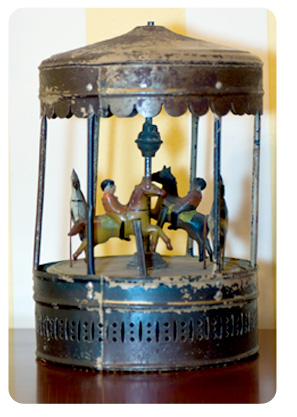
Circa 1875
France
Tinplate and paint
Eugene Field House
Descriptive Detail
Four different colored horses with their riders gallop under a scalloped canopy in this whimsical wind-up carousel from the early 1890s. There are traces of color in this delightful toy made of tinplate—thin sheets of steel plated with tin. Beginning in the mid-1800s, tinplate was the primary material for toy making because it was a cheap but durable substitute for wood. Although tinplate toys were originally assembled and painted by hand, by the late 1880s offset lithography was used instead. Colorful designs were first printed on the metal, the toy parts were formed by using a punch-like machine called a die to cut them, and then they were assembled. Construction of this carousel appears to use this “tab-and-slot” technique where two parts are connected by small flaps—one-half being inserted into corresponding narrow slots of the other half, and then bent to secure the connection. Because tinplate was easy to work with, didn’t cost much to make, and could be shipped less expensively and more easily than heavier cast iron toys, tinplate toys were popular with both the manufacturer and the consumer. The “key” which extends from the top of carousel suggests that it is spring-powered. This technique originated in Germany in the 1850s. During the late 1800s, toy makers, made more spring-powered wind-up toys than any other type of moving toys.
Local Historical Connections
Eugene Field was an avid collector of many things, including toys, and in particular wind-up toys. One of his biographers stated he had a “mania for curiosities and antiques” and “that his eye was ever alert for things rare and out of print.” Unfortunately, when his home caught fire, only nine toys from his extensive collection of 2,000 toys survived. Seven of those toys are housed in the Eugene Field House Museum.
National Historical Connections
The desire to bring inanimate forms to life is apparently basic to all humankind. As far back as ancient times, Egyptian, Greek, and Roman craftsmen managed to animate wooden statues through the use of hidden levers and hydraulic or pneumatic power, with seemingly magical results. Much later, town clocks in sixteenth-century Germany had mechanical clockwork-driven figures that struck the hour. These figures were the precursors of automata—life-size forms that were made for royalty in the seventeenth and eighteenth centuries. The elaborate clockwork gearing of automata enabled them to perform many amazing tasks, from writing sentences to playing musical instruments. However, by the 1850s automata were being replaced by mass-produced mechanical toys with spring-driven mechanisms and light, stamped gears instead of the heavy brass ones. Because they were inexpensive, these toys were available to all levels of society and became very popular in Europe and America. Toy manufacturing is but one of the many examples of innovation characterizing the Industrial Revolution as it developed in America in the nineteenth century. With the advent of plastics, the making of metal and mechanical toys gradually died out after World War II.
top^
next artifact}
|

|



